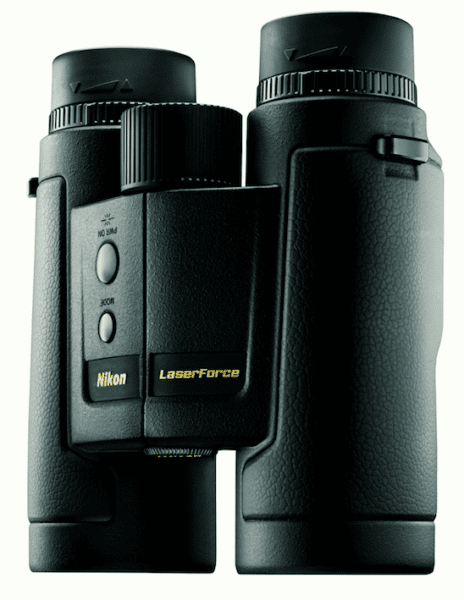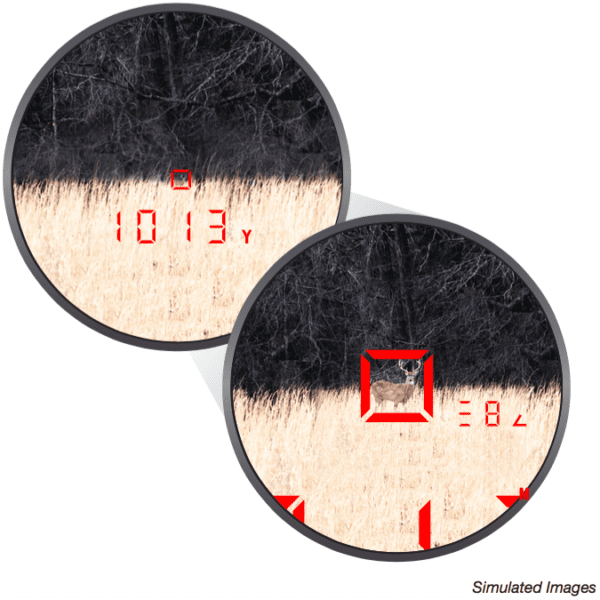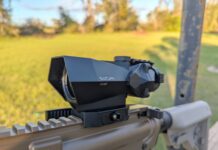That “S.” after my name doesn’t stand for Sherpa, but it may as well have yesterday as I schlepped a range finder, spotting scope, camera, and all manner of things great for turning gunpowder into loud noises as well as other things just for suppressing said noises. But why carry two tools when you can combine them and carry one? Nikon has done just that, marrying an apparent 1,900-yard rangefinder with a 10×42 binocular, complete with inclinometer for providing shooting angle-compensated ranges. It’s called the LaserForce, and Nikon’s press release follows . . .
Nikon Introduces LaserForce 1900-Yard Rangefinder Binocular
Nikon Sport Optics has officially announced the introduction of its highly anticipated binocular with a built-in 1900-yard laser rangefinder. The new LaserForce rangefinder binocular combines superior optical quality, ergonomic single-hand control, technologically enhanced features and a 100% backing with Nikon’s No-Fault Policy. This combination equates to a highly efficient, must-have optic for results-driven hunters and shooters.
LaserForce features a laser capable of ranging distances from 10-1900 yards* with instantaneous readouts on a crisp OLED display. Distances are displayed in 0.1 yd increments to 100 yards, and 1-yard increments over 100 yards. The OLED display offers a 4-step brightness adjustment, making it easily readable under any light conditions and against various objects.
Featuring Nikon’s ID (Incline/Decline) Technology to compensate for the effects that slope has on trajectory, LaserForce provides hunters and shooters with the compensated range necessary to make the shot, whether uphill, downhill or on level ground.
The 10×42 binocular component of the optic features ED (Extra-low dispersion) Glass. This superior glass corrects chromatic aberration that causes color fringing for high-resolution, contrast-rich images. Additionally, full multilayer-coated lenses and prisms and a reflective mirror coating that is applied on the mirror surface of the roof prism unit reveal pristine images. The long eye relief design, combined with turn-and-slide rubber eyecups facilitate a custom fit for users’ individual viewing needs, with or without eyeglasses.
The overall design of LaserForce was engineered with the specific needs of hunters and shooters traveling the world’s most rugged types of terrain. The rubber armoring conforming to a metal die-cast body provides a highly durable exterior with a grip that is tailored to the texture and shape of the human hand. LaserForce is also completely waterproof/fogproof with a nitrogen-purged body that prevents fogging or molding inside the optical system, even under significant changes in temperature.
https://www.youtube.com/watch?v=-W6R8l0fGBs
With a MSRP of $1,199.95, LaserForce is the single optic solution for serious hunters and shooters who mandate a high-quality binocular to acquire a distant target and a dependable laser to range the exact distance before taking the shot.







They had me hooked until I saw the price. When this kind of tech gets to the mid 3 digits in price I’m all in.
What? No accompanying App?
I found the price to be much less than I was expecting. But Nikon probably built a 1900m rangefinder into a pair of $300 binos. So the win is a dual use device with a good ranger (but oldchool feature set) into a marginal binocular.
For the record I would much rather have a great pair of binoculars even if it means I have to carry a separate rangefinder like my SIG Kilo2400.
Any idea what kind of batteries the Nikon eats?
My though as well. But then I started thinking why not just build the ran gefinder into a nice 4-16x riflescope and be done with it. Or does that get you into the mid 5 figures?
It’s happening. Within the next couple years I think we’ll see a riflescope with built-in rangefinder and ballistic calculator that, once you range your target, lights up the correct holdover to use as your new point of aim for elevation. Or, drop that last part and simply have a HUD kinda deal in there so you range it and the result isn’t yardage but your hold in MOA or Mils based on the ballistic info you inputted (likely via a phone app). Then, depending on the reticle type, you can either hold for the elevation or dial it in.
There certainly are scenarios, though, where you don’t want to be hefting your rifle and pointing it at everything just to range it. Binos w/ rangefinder is a great way to glass for targets, which can be a long process, while being capable of instantly ranging anything you see.
Your Scope Is Already Here. The BURRIS ELIMINATOR III.
Well, if you’re sitting on your front porch wondering how far the blonde down the street mowing her yard in her short shorts is…
Binocular vs monocular, someone please school me?
Arr, matey, monoculars are for pirates!
Binoculars are for those lubbers what don’t have an eye patch.
If you’re out hunting and you’re glassing the landscape for a while, using a monocular or spotting scope can cause a lot of eye strain. Many people literally wear a pirate patch so they can have both eyes “open” while doing it, reducing strain. Or, binoculars help with this. For the same amount of zoom and such, though, binos tend to be heavier and more expensive (as they’re basically two monoculars/spotting scopes in one). There are a couple spotting scopes out there with dual eye cups, though, which is slick.
We’re starting to get to Star Wars macrobinoculars, it seems…
Ouch, though Nikon does make nice Binos.
I’ll wait a couple of years – I think around $700 is by buy-in point for this.
Okay I-must-have-it-now early adopters and beta testers, it’s your time to shine.
… and bring the prices down.
Bushnell has made these for 500 to 1k with different magnification and laser capability. Still this nikon is have the price of the great leica combo. I want cannon to make one, because there image stabalized binos are the tits!
You’re right about Canon’s image stabilization, especially on a boat (or any moving platform). Once you use IS, you never want to go back. Add laser ranging to the mix, and here, just take all my money.
Very cool. It like the inclinometer feature.
For those who are cheap like me, there is the Simmons Volt 600 rangefinder. Under a hundred bucks and works almost flawlessly. One yard res., very accurate and ranges out to 400 or 600 yds depending on reflectivity. The only prob. is that the first reading requires two button presses instead of one.
IIRC, my bushnell 1 mile arc bino/range finder combo ran 900 bucks.
Last fall I lased a rock at a bit over 1,800 yds.
Comments are closed.